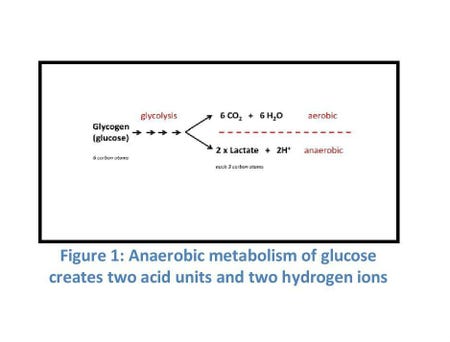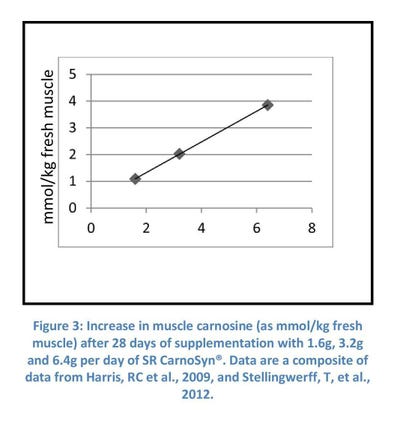Beta-alanine supplementation can help increase muscle carnitine and reduce muscle fatigue.
April 28, 2016

Energy production cycles
Energy is required by the human body for everything from breathing to weightlifting and running. Through the process of metabolism, the body produces energy via chemical reactions within the cells. The metabolic pathway used depends on specific energy needs. Short term needs can be met by anaerobic energy, literally “without oxygen."
The metabolic pathway used depends on specific energy needs. Short term needs can be met by anaerobic energy, literally “without oxygen."
The phosphocreatine/ATP and glycolytic pathways are used specifically for these anaerobic activities. For endurance, when energy must last longer, such as during aerobic activity, oxygen is required. For these activities, the body utilizes enzymatic reactions involving the Krebs cycle for energy production.
The carnosine and beta-alanine connection
Interest in beta-alanine supplementation as a means for increasing muscle carnosine has been fueled by studies demonstrating a positive effect on exercise performance and capacity. These studies have utilized a variety of models of sustained or intermittent high-intensity exercise, such as rowing, sprint running, sprint cycling, swimming, sustained heavy load carrying and downhill skiing.
Synthesis of carnosine, which occurs in muscle, is limited by the availability of beta-alanine obtained from de novo synthesis, a process that may, in part, depend on vitamin B6, or from the ingestion of muscle meat. In humans, ingested carnosine and other histidine-containing dipeptides (HCDs) are rapidly hydrolyzed to their constituent amino acids providing a source of dietary derived beta-alanine.
Survival of the fittest
Carnosine was first discovered in skeletal muscle where its concentration is higher than in any other tissue. Across different species its muscle concentration varies greatly. It is highest in animals reliant on fast movement for hunting and evading capture, and those facing prolonged bouts of hypoxia (i.e. a deficiency in the amount of oxygen reaching the tissues). Humans are unique in the animal kingdom in the range of high-intensity and explosive physical activities they perform involving upper trunk, abdominal, arm and leg muscles. This ability is the result of years of predation, escape and warfare where survival favored physical prowess. Today, these activities may take the form of competitive and recreational sports, physical training, everyday work activities, or military endeavors.
Carnosine synthesis
Carnosine is a dipeptide made up of two amino acids, beta-alanine and histidine. By combining with beta-alanine (not to be confused with alpha-alanine found in proteins), the histidine is prevented from linking with other amino acids to form proteins and, hence, is rendered chemically inert. This enables large amounts of histidine, the buffering component of carnosine, to be accumulated in muscle cells.
Synthesis of carnosine occurs in the muscle cells themselves, and is limited by the supply of beta-alanine. Although carnosine can be synthesized in the liver, the amount supplied to muscle in humans is low compared to our requirement for carnosine synthesis.
Eating meat and fish provides an important source of beta-alanine and can double the amount of carnosine in muscle, thereby doubling its contribution to H+ (hydrogen ion) buffering. To increase carnosine levels beyond the normal dietary levels obtained through these sources, dietary supplementation with beta-alanine is required.
Compared with other large mammals, humans have an unusually low muscle carnosine content, especially in the case of vegetarians where synthesis is reliant solely upon beta-alanine produced in the liver.
How muscle function may be compromised
Sustained and intermittent high-intensity physical activity is fueled by carbohydrates,  whereby glucose molecules released from muscle-stored glycogen are metabolized. For each molecule of glucose, two acidic chemical groups are generated, which are themselves destroyed when the end result is oxidation, producing carbon dioxide and water (aerobic metabolism). However, at high-work intensities the acidic groups are retained in muscle as lactic acid (anaerobic metabolism). The acidic, carboxyl groups are ionized in muscle, releasing H+. Because of the large amount of lactic acid accumulated, it is essential for muscle cells to neutralize the H+ generated as a first defense against muscle fatigue. Additionally, H+ must be exported as quickly as possible into the circulation (this may have to wait until completion of the physical activity itself.)
whereby glucose molecules released from muscle-stored glycogen are metabolized. For each molecule of glucose, two acidic chemical groups are generated, which are themselves destroyed when the end result is oxidation, producing carbon dioxide and water (aerobic metabolism). However, at high-work intensities the acidic groups are retained in muscle as lactic acid (anaerobic metabolism). The acidic, carboxyl groups are ionized in muscle, releasing H+. Because of the large amount of lactic acid accumulated, it is essential for muscle cells to neutralize the H+ generated as a first defense against muscle fatigue. Additionally, H+ must be exported as quickly as possible into the circulation (this may have to wait until completion of the physical activity itself.)
Unchecked, a rapidly rising H+ concentration would result in the rapid onset of muscle fatigue—bad news if you are competing in a sport or carrying a child up a long flight of stairs. However, neutralizing H+, either by buffering or export, is not perfect. Eventually the H+ concentration will rise, pH (a measure of this) will fall, and muscle fatigue will set in. But, by then you may have won a gold medal, or at least reached the top of the stairs!
Carnosine’s role in buffering muscle cells
The first defense against muscle fatigue is provided by physico-chemical buffers within the muscle cells. These must be present in large amounts to be effective and only three of these buffers are known:

Bicarbonate – but only that found in muscle at the start of exercise or activity, as the cellular concentration is highly regulated
Inorganic and organic phosphates – although in the early stages of exercise much of the phosphate is locked up in the form of phosphocreatine
Histidine – found in proteins and in carnosine
Carnosine is considered one of the most important molecular buffers, as it is available immediately in the muscle cells and is the only physico-chemical buffer that can be altered by diet and training. Its importance can be gauged by the very high levels of carnosine found in the muscles of animals that hunt or must escape by running. The levels found in these species are many times higher than those found in human muscle.
Supplementation and dosages
To achieve very high levels of muscle carnosine, the diet would need to be comprised almost exclusively of meat. Fortunately, that is no longer necessary with the availability of beta-alanine supplements such as CarnoSyn® and SR CarnoSyn® from Natural Alternatives International; both are scientifically proven, highly effective supplements protected by global patents.
University studies performed around the world using patented beta-alanine products (as SR CarnoSyn®) have demonstrated that the increase in muscle carnosine is dose dependent such that when supplementing with 6.4g per day, the increase is twice that achieved with 3.2g per day, which itself is twice that achieved with 1.6g per day. It is believed that eventually a plateau in the muscle content may be reached, wherein the increase above the pre-supplementation level is again dose dependent.
Maintaining this high level of carnosine in muscle requires ongoing supplementation with high enough doses over a continuous period of time. Reducing the supplementation dose, or stopping altogether will result in a gradual decline in the muscle carnosine content to a lower threshold, or right back to the pre-supplementation level. Supplementation with beta-alanine to increase muscle carnosine is equally effective in males and females, trained and untrained subjects, vegetarians and meat eaters, as well as in both young and older individuals.
Effectiveness of supplementation for active lifestyles
For close to a century we have known that muscle function can be compromised by falling pH as lactate and H+ accumulate within the muscle cells. At the whole body level this translates into muscle fatigue and loss of performance. Activities involving sustained or intermittent intense exercise including cycling, rowing, running, and skiing, along with common activities such as lifting and hauling paving stones or carrying a child, all require that muscles perform optimally and that pH is maintained.
Interest in beta-alanine supplementation is expanding well beyond even the serious athlete, to include all active individuals looking to achieve their best performance. How effective is supplementation? Over 55 scientific studies prove the muscle building benefits of beta-alanine (as CarnoSyn® and SR CarnoSyn®), including 6 months of clinical safety data. Citations to studies are available at http://www.carnosyn.com/clinical-studies.
Dr. Roger Harris earned a BSc and PhD in biochemistry from the University of Wales. His extensive research on creatine resulted in the description of creatine loading in muscle (Harris et al. Clin Sci 1992), and later to carnosine elevation by beta-alanine supplementation (Harris et al. Amino Acids, 2006). Dr. Harris was formerly Professor of Sport and Exercise Science, University of Chichester, United Kingdom. He is now retired, but his research efforts continue globally.
About the Author(s)
You May Also Like




.png?width=800&auto=webp&quality=80&disable=upscale)